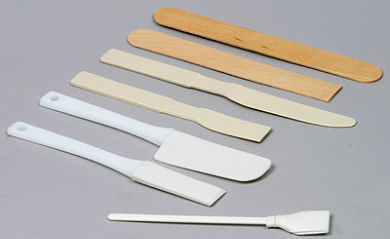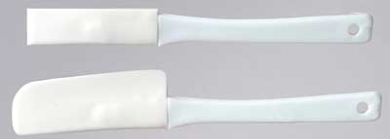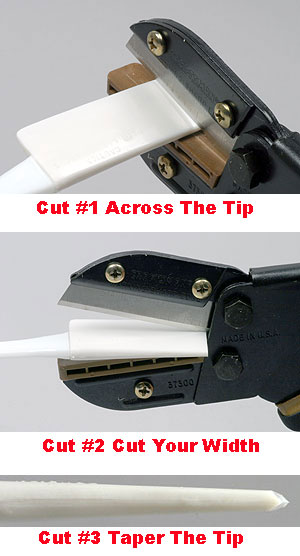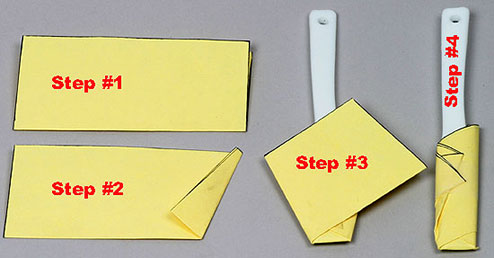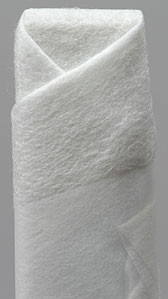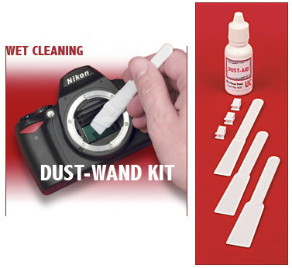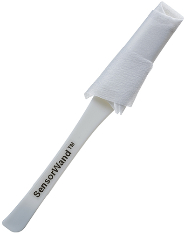DIY Projects/Wrapping Your Own Wands
We do not encourgae or recommend the wrap-your-own method as there is a much higher potential for unwanted results or damage with this method. Most of the sensors we have come across that have had physical damage were caused by the wrap-your-own method.
Building Your Own Swab/Swipe/Wand
First, we must realize that when using devices to clean the sensor that have not been recommended by the manufacturer it can void your manufacturer warranty. On the other hand, what is the alternative? Send it back to the manufacturer every time and pay $75+ hoping it comes back cleaner? As we already know, most photographers will clean their own cameras. If you have Fuji or Kodak cameras, you're covered because these companies support the consumers cleaning the sensor (with Pec*Pads® or Delta Wipes and Methanol).
For those looking to make your own Sensor Cleaning Tool, you must first consider what material to make it out of. No matter what material you use for a base, it should be wrapped with a Pec*Pad® or Delta Wipe. A regular lens tissue is also an option but the financial savings is nowhere worth the difference in quality. Pec*Pads® retail for only $.09 each and Delta Wipes for $.06 so this is an area I don't recommend pinching pennies. Let's get back to the materials for the wand itself. Your choices are rubber, wood and plastic and I recommend them in that order.
To start with our pesonal favorite, rubber, a small jar/icing spatula seems to work best as the handle is fairly rigid and the blade is a firm rubber. You can pick them up at most Ace Hardware stores for less than a dollar. These are easy to make, should allow enough pressure while not scratching the sensor. Some have expressed interest in the Rubbermaid brand of spatula. As you can see from the picture above, they are a bit fatter than the NORPRO brand. I compare the Rubbermaid Spatula for cleaning sensors to using a pair of needle nose pliers to remove a splinter. Remember, you are working down in a small hole and need to see what you're doing. The rubber is very simple to cut. I like using a tool I bought from Sears, the "Handi-Cut." This gives you quite a bit of leverage and cuts in a nice straight line. I have found that a straight edge razor works well. I don't recommend a pair of regular scissors, as they tend not to cut a straight line when going through rubber. The photos to the left show the simple three steps to cutting your own SensorWand®. Square the tip off, cut the desired width and then put a chisel point on the tip.
Wood
Wood is Nikon's preferred tool for in-house cleaning and are included in the kits they sell in Japan. The upper most item in the photo above is the Nikon Factory 7.5mm wide sensor cleaning tool which is basically a chopstick with a chiseled tip. The lower item is of a standard tong depressor with one end cut off square. Wood is stiffer than rubber but softer than plasti, so you will need to be cautious. Make sure you don't put too much downward pressure as to not crack the filter.
Plastic
Plastic is the hardest of the three and the favorite of Thom Hogan. Of course these are free with every visit to Wendy's. If you want to use plastic, please sand/file/melt the tip to help eliminate any sharp burrs.
Wrapping Your Wand
First, I must re-emphasize the need to do this on a clean surface The cleaner your work surface is, the better your results can be anticipated. For illustration purposes only, I'm demonstrating the steps to wrap your own wand with a piece of yellow paper instead of the Pec*Pad® or Delta Wipe you should be using. DO NOT touch the area of the Pad that will be coming in contact with the sensor with your hand or any other area of skin. Body oils can be transferred to the sensor this way.
- Fold the Pad in half
- With the folded edge facing you, take the right hand side and fold about 3/4" to the left at a 30º up angle.
- Place the SensorWand® inside the first fold and take the left hand corner and everything up to the tip of the SensorWand® to the right at a 30º up angle.
- Take the corner facing farthest right and wrap it tightly around the SensorWand™ watching to not deform the tip. Place a piece of Scotch tape or a rubber band around the Pec*Pad™ to hold it in place.
- Push the SensorWand® into the Pad, creating a nice tight squared off tip. Be very cautious not to tear the pad and expose the wand tip.
Dust-Wand Kit by Dust-Aid - This is a one-size-fits-all wrap your own kit. It comes with three different sized Dust-Wands so you are covered from APS-C up to Full Frame sensors. Also included are 50 Dust-Cloths to wrap with and 1/2oz of Ultra Clean.
- Pros: When done correctly, this method cleans the sensor 99.999% of the time.
- Cons: Manufacturer does not guarantee* not damage your sensor.
SensorWand® or Sensor Swipe or HomeMade Swab and with Pec*Pad® or Delta Wipes and Methanol - This method was originally developed as an economy version of the Eclipse™ and Sensor Swab™. Similar to the method used in-house by Nikon USA. An applicator device is made or bought and wrapped with a Pec*Pad. Eclipse is then applied for cleaning.
- Pros: This is the second most widely used method of sensor cleaning and when done correctly, cleans the sensor 99.999% of the time. In terms of effectiveness, this is the most inexpensive method.
- Cons: Manufacturer does not guarantee* not damage your sensor. The chemical used here (methanol) is flammable and cannot be shipped by air. Methanol is also illegal to possess in certain countries without a license.


